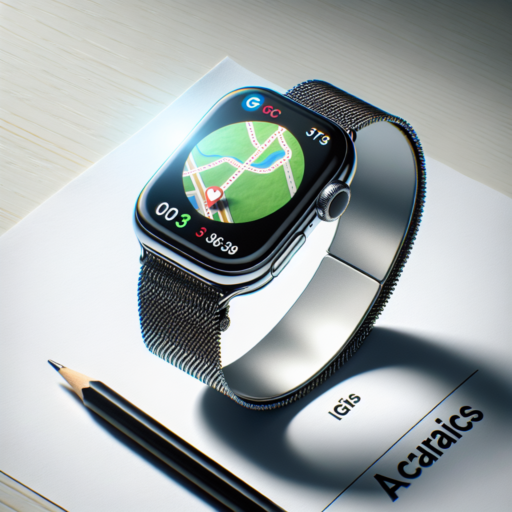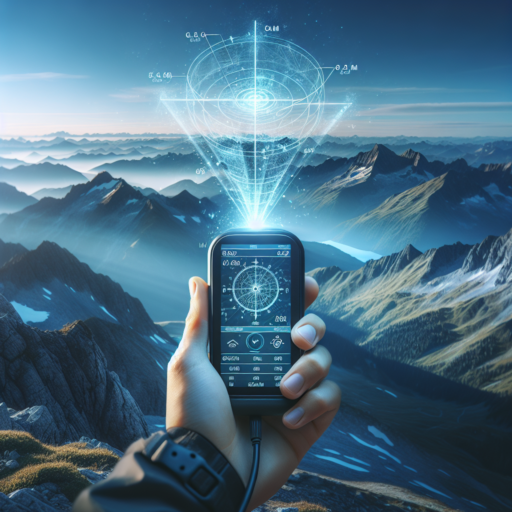Understanding the GPS Accuracy of Your Apple Watch
The Global Positioning System (GPS) technology in your Apple Watch is a pivotal feature that enhances the functionality of this wearable device, especially for those who love outdoor activities like running, hiking, or cycling. However, the question of GPS accuracy in the Apple Watch is a topic of interest for many users. How accurate is it, and what factors affect its precision? Let’s delve into the specifics of the GPS accuracy of your Apple Watch to give you a clearer understanding.
First and foremost, the Apple Watch utilizes both GPS and GLONASS satellite systems to pinpoint your location. This dual-system approach generally ensures better coverage and accuracy, especially in challenging environments where GPS alone might falter. Despite this sophisticated technology, various factors such as environmental conditions, interferences, and satellite positioning can significantly influence the GPS accuracy of your Apple Watch. For instance, urban canyons created by tall buildings or dense forests can obstruct the satellite signals, leading to inaccuracies in location tracking.
Moreover, the way you wear your Apple Watch can also impact its GPS performance. Ensuring the watch is snugly fitted on your wrist and not obstructed by clothing can help improve signal reception. Additionally, Apple frequently releases software updates that aim to enhance the GPS accuracy of its watches. Users are encouraged to keep their devices up to date to benefit from these improvements.
How Accurate is the GPS in Apple Watch Models?
Discussing the accuracy of the GPS in Apple Watch models involves delving into the intricacies of this wearable technology. Apple has made significant strides in enhancing the GPS capabilities of its watches, promising users precise tracking of their outdoor activities. However, the question remains: how accurate is the GPS in these devices? To understand this, one must consider the technical advancements and real-world performance of the GPS across various Apple Watch models.
Technical Enhancements in GPS Technology
Over the years, Apple has introduced improvements in the GPS technology used in its watches. Starting from the Apple Watch Series 2, which first featured built-in GPS, each subsequent model has seen enhancements in terms of signal acquisition speed and accuracy. The integration of more advanced chipsets and the ability to connect with not just GPS but also GLONASS, Galileo, and QZSS satellites has meant that users experience less signal dropout and quicker location pinpointing. These technical upgrades play a crucial role in the overall accuracy of the GPS in Apple Watch models.
Real-World Performance of Apple Watch GPS
In real-world usage, the accuracy of the Apple Watch’s GPS varies depending on several factors such as environmental conditions, the presence of tall buildings, and the body’s interference with the signal. Despite these challenges, users have reported good to excellent GPS performance in most outdoor activities, including running, cycling, and hiking. The precision in measuring distances and mapping routes directly ties into the enhancements made in the technology, showcasing Apple’s commitment to providing a reliable tool for fitness and outdoor exploration.
Improving Apple Watch GPS Accuracy: Tips and Tricks
Optimizing the GPS accuracy of your Apple Watch is essential for accurately tracking outdoor activities like running, walking, or cycling. While Apple has made significant improvements in GPS technology over the years, users can take further steps to enhance location accuracy. In this discussion, we’ll explore practical tips and tricks to ensure your Apple Watch provides the most precise data for your fitness and navigation needs.
Ensure Your iPhone Is Close By
One of the simplest yet most effective ways to improve the GPS accuracy of your Apple Watch is to ensure your iPhone is within close proximity. The Apple Watch can leverage the iPhone’s GPS module to attain more accurate location data. While your watch has its own GPS capabilities, the combined data can lead to enhanced precision in tracking, especially in challenging environments where signals might otherwise be weak or obstructed.
Update to the Latest Software
Regularly updating your Apple Watch and iPhone to the latest software version is crucial for maintaining optimal GPS performance. Apple continually refines and improves GPS accuracy and reliability with each software update. By keeping your devices up to date, you can ensure you’re taking advantage of the most current enhancements and bug fixes that can positively impact GPS tracking.
Managing settings related to location services can also significantly affect the GPS accuracy of your Apple Watch. Make certain that Location Services are enabled both on your iPhone and in the Apple Watch app. Additionally, consider adjusting the System Services settings to prevent unnecessary features from using location services, which can sometimes interfere with GPS performance. Focusing on these adjustments can contribute to more reliable and precise location tracking during your activities.
Comparing Apple Watch GPS Accuracy Across Different Models
When it comes to tracking workouts and outdoor activities, the GPS accuracy of your device is crucial. The Apple Watch series has evolved over the years, offering different models with varying levels of GPS performance. Understanding how these models compare can help you choose the right one for your fitness and navigation needs.
The first aspect to consider is the technology behind the GPS functionality. Early models of the Apple Watch, such as the Series 1 and Series 2, use a combination of Wi-Fi, GPS, and sometimes even the connected iPhone’s GPS to determine location. This can affect accuracy in areas where a GPS signal is weak or when the watch is not connected to an iPhone. On the other hand, newer models, like the Apple Watch Series 6 and Series 7, incorporate more advanced GPS technology, including GNSS (Global Navigation Satellite System) support, which enhances location tracking across a variety of environments.
Differences in GPS accuracy can also be attributed to software updates and enhancements. Apple continually updates its watchOS to improve functionality, including how the watch’s GPS interacts with satellites and processes data. Therefore, it’s not uncommon to see GPS performance improvements in older models following an update. However, the inherent hardware limitations mean that newer models, with their updated technology, generally offer more precise location tracking right out of the box.
Real-World Performance: Apple Watch GPS Accuracy Tested
In the realm of smartwatches, the Apple Watch stands as a beacon of innovation and functionality. Among its myriad features, the GPS capability is one of the most celebrated, offering users the ability to track their movements with impressive precision. This segment delves into the real-world performance of the Apple Watch’s GPS accuracy, shedding light on how it stands up to everyday use and specialized scenarios alike.
The rigorous testing of the Apple Watch’s GPS accuracy reveals a multifaceted view of its capabilities. For runners, cyclists, and outdoor enthusiasts, the accuracy of GPS data is paramount, not only for tracking distance but also for analyzing performance and improvement over time. Through a series of controlled outdoor activities, including open-field running, urban navigation, and mountain biking, the Apple Watch demonstrates a high level of precision, rivaling dedicated GPS devices. These activities highlight its adeptness at maintaining a consistent signal, even in environments challenging for GPS technology such as urban canyons and densely wooded areas.
However, it’s important to note that while the Apple Watch’s GPS performance is commendable, factors such as weather conditions and interference from tall buildings can occasionally impact accuracy. Despite these challenges, the smartwatch manages to maintain a reliable track record in various conditions, showcasing its robustness. The nuanced understanding of the Apple Watch’s GPS reliability offers potential users a comprehensive insight into what they can expect from this feature in their everyday lives and athletic pursuits.
Common GPS Tracking Issues on Apple Watch and How to Fix Them
Encountering GPS tracking issues on your Apple Watch can be frustrating, especially when relying on it for accurate distance and route information during workouts. From inaccurate distance tracking to the complete absence of GPS data, these problems can disrupt your fitness routine and overall user experience. However, there are several strategies to troubleshoot and resolve these issues effectively.
Ensuring Location Services are Enabled
One of the first steps to resolve GPS tracking issues is to verify that Location Services are enabled both on your iPhone and Apple Watch. This is crucial for accurate GPS data collection. To check, go to your iPhone’s Settings, tap on Privacy, select Location Services, and ensure it’s turned on. Then, scroll down to ensure that Apple Watch Workout is set to «While Using» or «Always».
Updating Software on Your Devices
Outdated software can sometimes be the culprit behind GPS tracking issues. Apple frequently releases updates to improve functionality and fix bugs, including those related to GPS. To ensure optimal performance, check that your iPhone and Apple Watch are running the latest version of their respective operating systems. This can be done by going to Settings on your iPhone, tapping on General, then Software Update. For your Apple Watch, open the Watch app on your iPhone, tap General, and select Software Update. If an update is available, install it to potentially solve any GPS-related issues.
Apple Watch GPS Accuracy for Running, Cycling, and Outdoor Activities
When it comes to tracking your performance in running, cycling, and various outdoor activities, the Apple Watch stands out for its GPS accuracy. Integrating state-of-the-art technology, Apple has continuously improved the precision of geographical positioning, making it a reliable companion for athletes and fitness enthusiasts. Understanding the significance of accurate data, Apple incorporates advanced algorithms to minimize discrepancies and ensure that your physical endeavors are meticulously recorded.
The performance of the GPS in the Apple Watch is optimized for a wide range of activities. Whether you’re a marathon runner, a cycling enthusiast, or someone who enjoys hiking in the great outdoors, the device’s ability to effectively track distance, pace, and routes enhances its value. The seamless integration with Apple’s Health app further enriches the user experience, offering insightful analytics that aid in personal goal setting and achievements. Moreover, the watch’s GPS functionality is critically acclaimed for its rapid location acquisition, which means less waiting time before starting an activity and more accuracy throughout.
Enhancements in GPS technology have also made it possible for the Apple Watch to deliver exceptional results in varied environments. From urban landscapes with tall buildings to dense forests and remote trails, the device demonstrates a high level of precision. This is paramount for cyclists and runners who frequently traverse through diverse terrains. Additionally, Apple’s commitment to improving satellite connectivity ensures that users experience minimal disruptions, making every outdoor adventure as reliable as the last.
No se han encontrado productos.
Maximizing Battery Life and GPS Accuracy on Your Apple Watch
Improving the efficiency of your Apple Watch isn’t just about extending its battery life—it’s also crucial for enhancing the precision of the GPS functionalities that many of us rely on for outdoor activities. Whether you’re tracking your daily jog or navigating a new city, these integral features can greatly benefit from a few adjustments. Here, we’ll delve into tips that specifically focus on how you can make the most out of your Apple Watch by optimizing both battery life and GPS accuracy.
Adjusting Settings for Optimal Performance
Key to maximizing your Apple Watch’s capabilities is tweaking its settings. Begin by reducing the screen’s brightness and limiting app notifications, which can drain the battery rapidly. Additionally, consider disabling the ‘Wake Screen on Wrist Raise’ feature, as this can save a significant amount of power. For GPS accuracy, ensure that ‘Motion Calibration & Distance’ is turned on. This helps your Apple Watch better understand your movement patterns, significantly enhancing the accuracy of distance and pace measurements during outdoor activities.
Streamlining Apps and Watch Faces
Another strategy involves carefully selecting which apps and watch faces you use. Opt for watch faces with fewer animations and complications to minimize power consumption. When it comes to apps, regularly review and remove those that are unnecessary or seldom used, as many run background processes that can affect both battery life and GPS performance. Specifically, for outdoor workouts, consider using only the essential GPS-based apps to ensure that GPS accuracy is not compromised by other apps competing for resources.
Consistent Firmware Updates and Calibration
Last but not least, keeping your Apple Watch up-to-date with the latest firmware is critical. Updates often include optimizations that can enhance battery longevity and improve GPS accuracy. Furthermore, regularly calibrating your watch’s GPS can also make a substantial difference. You can do this by ensuring a clear view of the sky during outdoor walking or running sessions and keeping your iPhone nearby if it’s paired with your watch. This procedure helps your device learn your stride length over various speeds and terrains, further increasing GPS precision.
User Experiences: How Accurate is Apple Watch GPS for Daily Use?
The accuracy of the GPS system in the Apple Watch has been a topic of discussion among many users who rely on it for daily activities such as jogging, walking, or even navigating through city streets. In terms of user experiences, many find the Apple Watch GPS to be remarkably precise, offering the convenience of location tracking without the need to carry a smartphone. However, the accuracy can sometimes vary depending on several factors.
One of the primary factors affecting GPS accuracy is the surrounding environment. Users have reported more reliable GPS tracking in open areas compared to densely populated urban areas where tall buildings might interfere with the signal. Similarly, the presence of trees and other large obstructions in outdoor settings can also impact the accuracy of the GPS data collected by the Apple Watch. Despite these challenges, the Apple Watch utilizes advanced technology to provide as accurate readings as possible under varying conditions.
Moreover, the Apple Watch continuously improves its GPS accuracy through software updates. Apple’s dedication to enhancing user experience can be seen in the frequent updates aimed at improving the functionality and precision of the GPS. These updates often include algorithm adjustments that better adapt to different environments and usage patterns, further enriching the user’s experience with reliable location tracking. Nevertheless, for those seeking the utmost accuracy, pairing the Apple Watch with an iPhone can enhance the GPS data quality, leveraging both devices’ capabilities for more precise location information.
The Technology Behind Apple Watch GPS Accuracy
The technology that powers the GPS accuracy of the Apple Watch is sophisticated, leveraging both hardware and software innovations to deliver precise real-time location tracking. At the core of this functionality is the integration of a high-sensitivity receiver and the utilization of multiple satellite systems. This blend not only enhances the precision but also improves the speed at which the watch can lock onto a GPS signal, even in challenging environments.
Advanced Algorithms and Machine Learning play a pivotal role in refining the GPS accuracy of Apple Watches. By analyzing vast amounts of data, the watch can predict movements and offer more accurate positioning. This is particularly beneficial in urban areas, where high-rise buildings could potentially interfere with satellite signals. The algorithms continuously learn and adapt to the user’s patterns, ensuring that accuracy is maintained across a variety of scenarios.
Furthermore, the Apple Watch benefits from Apple’s Custom-Designed S5 Chip. This chip is not only powerful but also energy-efficient, allowing for extended GPS usage without significantly draining the battery. It facilitates the processing of complex calculations required for real-time positioning, ensuring a seamless integration with the watch’s operating system to provide a smooth and responsive user experience.




